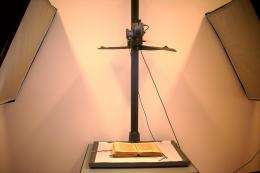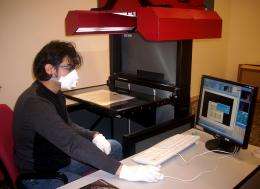Star images helping to save Vatican books

(������ƵOrg.com) -- Antique books in the Vatican Library are being digitised to preserve them for future generations using a technique developed through ESA to store satellite images of the sky.
The Library needed a way of scanning the delicate old manuscripts and storing the files so that they could still be read in hundreds of years. The answer was the special file format used by ESA for most of its scientific satellites.
In the 1970s ESA and NASA scientists developed ‘FITS’, the flexible image transport system format, stemming from radio astronomy. FITS is now used to store data from many space missions.
“Any kind of data you can use for astronomy can fit inside this format,” says Pedro Osuna, Head of ESA’s scientific archives.
That made it ESA’s top choice for storing the mountains of information from almost all of the agency’s astronomy missions. The pioneering Herschel, Integral, XMM-Newton and SOHO space observatories all use it.
In this digital era, finding a storage format for the ages is a big challenge facing researchers, archivists and librarians the world over. FITS is the answer.
“If you have a tool that can read FITS today, you can read FITS files from 20 years ago,” Mr. Osuna says. “It’s always backwards compatible.”

Today, the format developed to save images of the stars is being tailored for a very different purpose: preserving one of the world’s largest collections of ancient books.
“Most space missions, like the Hubble Space Telescope, use FITS to store and study scientific data,” says Giuseppe Di Persio of Italy’s National Institute for Astrophysics.
Dr. Di Persio is now working with the Vatican Library in Rome on a pilot project to scan part of its massive collection, saving it as FITS files to make sure they are available to future generations.
Founded in 1475 and one of the world’s oldest libraries, the Vatican Library houses tens of thousands of manuscripts and codices from before the invention of the printing press – some are 1800 years old.
In addition to making the contents more accessible, digitising will help to preserve the originals.
“It’s very dangerous for the manuscripts every time someone touches them,” says Luciano Ammenti, Director of the Vatican’s Information Technology Center, spearheading the project.
He chose FITS because of its longevity and also because it is open source – not linked to any one company.
The format also lends itself to the fragile, ancient tomes in the Vatican’s collection. Pressed against a plate of glass, the old pages can be distorted, but scanner software developed for the project automatically calculates the different angles, resulting in an accurate, flat image.
The secret of the format is that the instructions needed to read and process the data are in a text header tacked on top of the data. In a century, when computers will presumably be very different, that means all the information needed to decode them is in the same files.
FITS can always be read without the need for conversion to another format, which could lose information or be incompatible with future systems.
As Dr. Di Persio says: “Once FITS, always FITS.”
Provided by European Space Agency





















